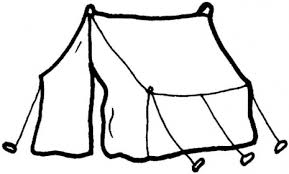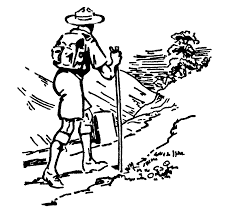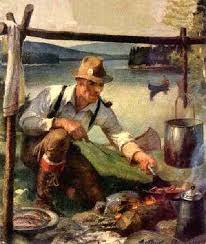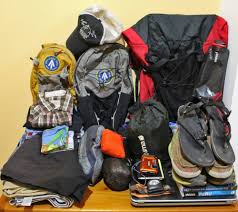CMW Guide to Bushwalking
Welcome to the CMW

The Coast and Mountain Walkers of NSW is really just a group of people who love the bush. Each weekend, we go in small groups to visit a few of the thousands of beautiful peaks and rivers in the Sydney region.
Bushwalking is a means to many ends—to enjoy wildflowers, to spot birds and animals, to camp in majestic places, to paint, to take photographs, to read good books by babbling brooks.
We have produced this booklet to:
• Explain the technicalities of going on a club walk.
• Give a few tips about equipment and food needed on a typical walk.
• Point out the rules of responsible bushwalking.
Find information below on the walks program, clothing, footwear, packs, sleeping bags, tents, stoves, first-aid, food, bushwalking rules and etiquette, navigation and other useful tips.
Going on a walk

Don’t worry if you haven’t done any bushwalking before. There are no special requirements, except perhaps a sense of humour.
If you are new to bushwalking, take care to choose a walk that is appropriate to your level of fitness and experience.
Although you may feel you are very fit—perhaps you even run marathons—fitness alone is no substitute for the numerous skills of an experienced bushwalker. It is far better to go on a walk that you find easy, than on one that is an ordeal.
The best approach is to attend the club meetings and talk to the committee members and the leaders. This allows us to suggest suitable walks and to help make your first bushwalks enjoyable.
Understanding the walks program
The Current Walks Program is published on our Website - links to which are emailed to all members as Leaders
submit new trips or change existing ones (through the Walks Secretary).
Each walk includes a brief description and the following technical details:
• Distance and Grade. These give a guide to the difficulty of the walk; they are described below in more detail.
• Maps. These are the maps that cover the walk.
• Transport. We share transport as much as possible—this is not only cheaper, it is also much more sociable. The figure is the amount each passenger gives to the driver to help pay for petrol, wear and tear.
• Leader. The person who has volunteered to lead the walk (everything we do is voluntary).
Distance and grade
Distance is the approximate distance you have to walk each day (it also takes into account the amount you have to climb and descend). The values are: short (under 10 km), medium (10 to 20 km) and long (over 20 km).
Grade is the type of terrain over which you have to walk. The values are:
• Easy. Good tracks or open terrain.
• Medium. Bush tracks or fairly easy terrain.
• Hard . Thick scrub, some scrambling and walking along creeks.
• Exploratory. The leader is not familiar with the area—so expect rough terrain.
• Abseiling. Descending over cliffs by rope.
• Canyoning. Swimming or liloing through the canyons. The water is very cold, even in mid summer, and wetsuits may be recommended.
Check the Trip Grades and Distances page for pictorial representations of walk difficulty.
Unfortunately, although these terms will eventually become meaningful, they are very hard to interpret if you have not done much bushwalking. The wisest approach is to start with short/easy walks and to talk to as many club members as possible.
Making arrangements Before going on a walk, you must talk to the leader — generally, no later than four days before the walk.
Both you and the leader need to establish your suitability for the walk. Obviously, if you are new to the club, both of you will tend to be apprehensive.
Going to and from an overnight walk
The leader usually arranges transport on the Thursday before the walk. The party members usually leave Sydney very early on the Saturday morning, or on the Friday evening.
Sydney being the size it is, the drive typically takes between two and four hours.
Because eating is a major obsession with bushwalkers, we often stop for a coffee or meal on both inward and outward journeys.
It is also a good idea to take along a clean set of clothes for the return journey because you may arrive back at the car sopping wet from sweat or rain.
Keeping together
It is essential that you keep in contact with the rest of the party at all times.
Obviously, the best solution is to pay attention to where the other party members are going. And always make others aware of what you are doing—for example, if you stop to relieve yourself, tell someone else first.
It is difficult to give precise instructions as to what to do if you ever become separated—other than don’t panic—but keep these tips in mind:
• As soon as you think that you have lost the party, shout out. It is far better to shout too often than not to shout enough.
• If you have no idea of where the others are, stay where you are; the others will soon come back.
• Don’t start racing to ‘catch up’. You may actually be running away from the party.
• If you have been following a track or creek, you may have taken a wrong turning. If you remember seeing a junction, return to that junction; but no further.
The moral is keep in touch with the others at all times; and learn how to navigate.
Further information is on:
https://bushwalkingmanual.org.au/the-trip/keeping-the-group-together/
Being overdue
Sounds ominous! Fortunately, accidents are quite rare — bushwalking is far safer than crossing a Sydney street or braving an after-Christmas sale.
The most common reason for being late is localised flooding. For example, you may be stuck on the wrong side of a rising creek, or the bush track leading back to civilisation may be impassible.
Please remember to tell your relatives and friends not to worry if you are late. If you are delayed, you will generally be able to make contact the next morning.
Further information on being lost and the group being lost can be found in the above Keeping-together link and on:
https://bushwalkingmanual.org.au/emergencies/if-you-are-lost/
and on:
https://bushwalkingmanual.org.au/emergencies/group-member-lost/
Safety
An overview on bushwalking safety can be found on:
https://bushwalkingmanual.org.au/trip-planning/safety/safety-essentials/
And comprehensive safety detail is on:
https://www.bushwalkingnsw.org.au/safety/Taking the right gear
Here we provide some tips for major items, such as clothing, footwear and packs. A checklist at the back of this booklet lists everything you need on a typical weekend walk.
If you don't already have your own gear:
We recommend that you hire before you buy—only after you have used quality gear and talked to other club members will you know what is appropriate to your needs.
In addition to the Bushwalking Victoria links below, BNSW has a wealth of information on: https://www.bushwalkingnsw.org.au/gear/
Clothing
Your clothing requirements vary greatly with the seasons, and with the areas in which you walk. In summer, you wear clothing to protect you from the sun (and insects at night). In winter, you need to keep warm.
Comprehensive detail on clothing can be found on:
https://bushwalkingmanual.org.au/equipment-and-clothing/clothing/
Footwear
Many bushwalkers in Sydney wear sandshoes or running shoes. These are generally the most suitable for the types of walks we do near Sydney.
If you want to wear boots, buy only quality ones (as stocked in bushwalking shops) and choose them very carefully. And break them in before going on any walk.
Comprehensive detail on footwear and gaiters is on:
https://bushwalkingmanual.org.au/equipment-and-clothing/footwear/
Pack
• Pack length. The majority of packs are designed for males of average height or taller—if you fall into this category, you will have a wide choice. If you are shorter than about 170 cm, you have to choose your pack carefully and make sure that its length (from the shoulder straps to the waist-belt) is right for you.
• Pack capacity. The initial inclination of many people is to choose a large pack—but this is often an unwise move.
With a bit of experience you can learn how to pack efficiently and to carry the minimum needed for comfort
and safety.
As a general rule, a pack with a capacity of 65 litres is adequate for even the longest walk.
• Pack weight. Choose a pack that is as light as possible — certainly less than 2 kg. In practice this means a pack that has a simple design, and does not have lots of extra straps.
• Single compartment. Choose a single compartment pack rather than a dual compartment one. (Dual compartment packs are heavier, harder to waterproof, and harder to pack efficiently.)
Detailed information is on:
https://bushwalkingmanual.org.au/equipment-and-clothing/packs/
Sleeping bag
Unfortunately, choosing a sleeping bag is more difficult than choosing a pack because of the wide range of temperatures that you may find yourself subjected to.
Most experienced walkers have two bags: a light one for non-winter trips (often called a ‘three season’ bag) and a heavier (‘four season’) one for winter trips. We recommend that you buy a three season one first, unless you want to go on a snow or winter trip.
All good sleeping bags are made from ‘superdown’ (very fine duck feathers), and come in standard and long sizes.
Further information is on:
https://bushwalkingmanual.org.au/equipment-and-clothing/sleeping-bags/
Tent
https://bushwalkingmanual.org.au/equipment-and-clothing/tents/
Stove
On some walks you must use a stove—typically because you will be camping in an environmentally fragile or popular area. If you are unfamiliar with a walk, ask the leader whether you need a stove.
Further information on stoves is on:
https://bushwalkingmanual.org.au/equipment-and-clothing/stoves/
and safety tips are on:
https://bushwalkingmanual.org.au/food-and-water/stove-safety/
First-aid
A first-aid introduction, some procedures, tips, and kit contents can be found on:
https://bushwalkingmanual.org.au/emergencies/first-aid/
and on the BNSW site: https://www.bushwalkingnsw.org.au/bushwalkers-health/
Pack kit items in a suitable waterproof container — altogether, your first-aid kit should weigh less than 300 gm.
Miscellaneous tips
Apart from the major items and food, you also need to carry other things, such as toiletries and cooking gear. The trick is
to take only those things that are essential, and only then amounts you need.
Here are a few tips:
• Take only small quantities — for example take an almost empty tube of toothpaste, an almost finished roll of toilet paper and a small piece of soap.
• Transfer things such as butter and honey (and face cream), to small plastic containers.
• Take an aluminium, not an stainless steel, pot for cooking.
• Take a plastic, not an aluminium water bottle. The cheapest — and perhaps the best—water bottle is a simple 1.25 litre fizzy drink container.
• Take plastic, not metal, spoon and fork—camping shops sell light, unbreakable plastic cutlery.
• Take a light, simple steel knife; not a heavy, fancy one that has a built-in kitchen sink.
• Take a torch. (A headtorch is ideal, but talk to club members before buying one so that you get one that is appropriate to your needs.)
• Line your pack with a large plastic bag — such as a garbage bag — to keep everything dry. (Most packs are not very waterproof.)
• Don’t carry any glass containers because they are heavy and fragile.
• Don’t take deodorants — everyone smells after a day’s walking, so no-one is going to notice your body odour.
• Don’t take a towel; a face towel or Chux towelette is quite adequate.
Buying gear
When buying any bushwalking gear, only two words are important: quality and appropriateness.
Only buy quality, brand-name gear; there is a lot of cheaper gear in the shops, but, with a few exceptions, it is neither suitable nor comfortable.
Similarly, only buy equipment that is appropriate to your needs. Even good quality equipment is a waste of money if it doesn’t fit—boots are a prime example—or if you don’t need it for the types of walking you do—such as an expensive, heavy snow-tent on a walk to the Blue Mountains.
Tips from BNSW are on: https://www.bushwalkingnsw.org.au/suppliers/
Taking the right food

Eating is one of the joys of life—and everything tastes so much better after a day’s walk.
Keeping things light
Choosing the right types and quantities of food for a walk is another of the fine arts of bushwalking. Remember that you have to carry it; and if you take too much, you also have to carry it out.
Keep the following points in mind:
• Take only the amount you need. Think about what you normally eat for each meal. If, for example, you eat a cupful of muesli for breakfast, measure this amount into a plastic bag and take only that.
• Take fresh food in moderation; for example, an apple for each lunch. Although fresh food tastes better, it is 70% to 95% water.
• Take complex carbohydrates such as bread, rice and noodles—you need these to give you sustained energy.
• Avoid tins—again, they contain mostly water.
• Don’t take packaged fruit juices because they are just flavoured water; and the water in our national parks tastes much better and doesn’t contain preservatives or artificial flavours.
• Remove excessive packaging; for example, remove the outer packet of packet soups.
Food for a typical weekend walk
On a weekend walk you can eat more or less what you would eat at home. Whatever you bring, it should weigh between 2.0 and 2.5 kilograms (for two breakfasts, two lunches and one dinner). If you’re very concerned about weight, take only dry food and don’t take any tins—this will reduce the weight to less than 1.5 kg.
Check out our great bush recipes submitted by some of our members:
Further information on food planning and tips can be found on:
https://bushwalkingmanual.org.au/food-and-water/food-for-bushwalking/
Checklist
This checklist includes the things you need on a typical walk. It does not include anything specialised, such as mittens or an air mattress, that are required on some walks.
Always check with the leader whether you need any special equipment.
General

Pack
Pack liner (garbage bag)
Sleeping bag
Sleeping bag liner (obligatory with borrowed bags)
Tent or fly, pegs and poles
Ground sheet if you have a fly
(a plastic sheet 1 m by 2 m)
Sleeping mat or ‘Thermarest’
Stove (if fires are not permitted on the walk)
Billy
Cup (plastic)
Cutlery (plastic spoon and fork, small metal knife)
Water bottle (at least 1 litre)
First-aid kit
Map(s)
Compass
Torch
Matches and fire starters in waterproof container
Two or three plastic bags (to store wet/dirty clothing and to carry out rubbish)
Clothing
Worn while walking
Shorts or long trousers (not jeans made of cotton)
Shirt (long sleeved)
Sandshoes or boots
Socks
Gaiters
Hat (wide brimmed)
In your pack
Toiletries
Toilet paper
Lip sunscreen
Sun cream
Soap
Face towel or Chux towelette (not a towel—it’s too heavy)
Toothbrush
Toothpaste
Dental floss
Mosquito repellent
If it’s not on this list, do you really need it?
For a weekend walk your fully laden pack should weigh between 9 and 11 kg.
Bushwalking rules
Our guiding ethic is: Our impact on the bush should be as small as possible—ideally, it should be impossible to discover where we have walked or camped.
Flora and Fauna/Environment and Conservation
All native flora and fauna are protected in national parks. For us, this rule applies wherever we walk.
Information on Ecosystems, Environmental principles and Environmental awareness and campaigns can be found on:
https://bushwalkingmanual.org.au/environment/environment-and-conservation/
and the BNSW site at: https://www.bushwalkingnsw.org.au/bush-issues/
Rubbish and Minimal Impact Bushwalking
Don’t burn anything, other than paper, on the campfire. Don’t even burn paper-based packaging that is lined with aluminium or plastic.
Going to the toilet Select a spot well away from the campsite, tracks and creeks. If you are having a dump, dig a small hole with a stick or a rock (or even the heel of your shoe) and cover up after.
When washing with soap, fill a water bucket and wash well away from the creek, so that the water drains into the soil.
When swimming, swim downstream from the campsite.
Fires: We are extremely fortunate in Australia to be able to have campfires in some of the places where we walk. So, if you light a fire:
• Observe any fire bans. (If a fire ban is likely, you should take food that does not require cooking.)
• Make sure that the fire is out before leaving it.
• Don’t make the fire too big, especially if wood is scarce.
• If you use firewood stored in a hut, replace it before leaving—the huts and the firewood are the common property of all bushwalkers.
On some walks you must use a stove—typically because you will be camping in an environmentally fragile or popular area. If you are unfamiliar with a walk, ask the leader whether you need a stove.
Farmland: We rely on the friendliness of many farmers. Comply with their requests because a careless act on your part could prove extremely expensive to a farmer. In particular, when crossing farmland, leave gates as you find them.
Keep your gear and clothes clean:
Biosecurity is increasingly critical to the protection of our environment. Weeds, pests and diseases are major threats to Australia’s native plants and animals. They can hitch a ride on muddy hiking boots, in wet fishing gear or even hidden on the dirty rims of your car.
Clothing:
• Choose ‘no weave’ or ‘close weave’ clothing like outdoor shirts to stop seeds sticking
• Wear knee-length gaiters or long pants and sock protectors
• Carry a zip-lock bag to dispose of seeds picked off clothing and socks and carry it out; dispose of it in the ‘red bin’.
• Make sure pockets are closed especially when accessing road verges or car parks where ground disturbance is more prevalent or when proceeding through disturbed areas or thick bush.
Gear:
Before you go into natural areas, ensure your gear is thoroughly clean
• Ensure you have washed or sprayed your tent pegs, walking poles, bottom of gaiters and bottom of packs
• Ensure your vehicle is clean.
When you are out in the bush
• Use a boot cleaning station if available
• Keep to walking tracks if you can, to avoid spreading diseases into untracked areas
• Empty tent of debris where you have camped – don’t carry the seeds many kms from one area into another
• Thoroughly clean and remove all dirt and plant material from backpacks, boots, socks and other gear before you leave a site and check before going to another site, especially in wet conditions.
• Carry a small brush or toothbrush for removing seeds
• When parking your car, avoid weedy areas
• Keep a spray bottle of 70% methylated spirits to 30% water and a brush to clean tyres, canopies etc. before you leave a site.
Afterwards
• Think about where you will empty the ‘stuff’ on your car’s floor mats
• Think about where the water runoff will go when you wash your car.
Comprehensive info on Minimal Impact Bushwalking can be found on:
https://bushwalkingmanual.org.au/environment/minimal-impact-bushwalking/
Using map and compass, and general navigation
A comprehensive guide to using map and compass, with on-links, is at:
https://bushwalkingmanual.org.au/the-trip/practical-navigation/map-and-compass-basics/
and at: https://bushwalkingmanual.org.au/trip-planning/map-apps-and-digital-maps/
One of the on-links is an excellent .pdf guide from Geoscience Australia:
https://d28rz98at9flks.cloudfront.net/102240/Map_reading_guide_v4.pdf
Navigation techniques are on:
https://bushwalkingmanual.org.au/the-trip/practical-navigation/navigation-techniques/
Difficult conditions are on:
https://bushwalkingmanual.org.au/the-trip/practical-navigation/navigation-in-difficult-conditions/
Other navigation aids/techniques are on:
https://bushwalkingmanual.org.au/the-trip/practical-navigation/mobile-phone-navigation/
and: https://bushwalkingmanual.org.au/the-trip/practical-navigation/handheld-gps-navigation/
References:
This web page has been updated to include references to the Bushwalking Victoria Bushwalking Manual,
and to the Bushwalking NSW website.
© April 2021, Coast and Mountain Walkers of NSW Inc.
www.cmw.asn.au

